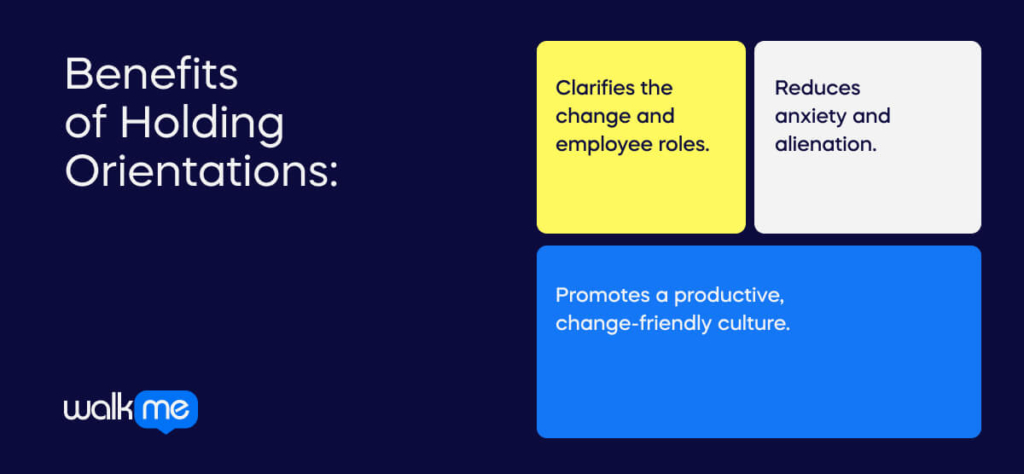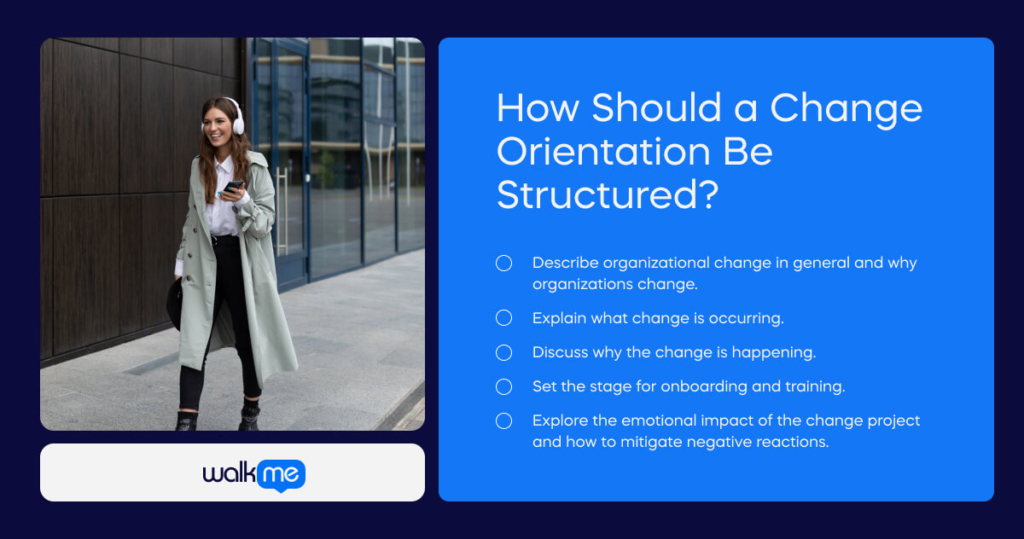A change orientation acclimates employees to an organizational change program and, when properly implemented, these orientations can significantly benefit both employees and employers.
Below, we will explore these benefits in detail, then look at how orientations should be structured and how they differ from other key elements in a change project.
Why Is It Important to Orient Employees to Organizational Changes?
Though every change model differs, it is widely recognize that organizational changes often have a major impact on employees’ psychology, behavior, and habits.
It is not easy, after all, to adjust to new workflows, new behavioral requirements, new digital tools, new organizational structures, and so forth.
If such changes are not executed smoothly, employees can easily become resistant to change. Among other things, that resistance can lower productivity, reduce innovation, and negatively impact a change project.
A change orientation, as the term suggests, helps employees understand and align themselves with a change project.
There are several benefits to holding these orientations:

- Employees will know what organizational change is occurring, why it is occurring, and what their role is
- Orientation mitigates or prevents negative emotions that can hinder a change project, such as feelings of anxiety or alienation
- Business leaders can cultivate a culture that is open to change, which, in turn, will be more efficient and productive
Also, as we will see below, a well-structured orientation can act as a doorway to the onboarding process, which is an essential part of every change program.
How Should a Change Orientation Be Structured?

Change orientations should build awareness of change management in general, the change project, and help prepare employees for the work that lies ahead.
An effective orientation will:
- Describe organizational change in general and why organizations change. This type of context can provide a general understanding of why organizations change. That understanding, in turn, provides a general rationale for any specific organizational change program. That knowledge alone can go a long way towards reducing employees’ anxiety and fear of a project.
- Explain what change is occurring. Awareness of change begins with the “what” of a change project. This means explaining what the organization will look like after the change, how individual employees’ roles will shift, and what steps must be taken along the way.
- Discuss why the change is happening. It is a good idea to explain organizational change as a general process, as mentioned above. It is just as important, though, to explain why a specific organizational change is occurring. If, for instance, a company is undertaking an organizational transformation program in order to improve organizational resilience, then employees should be provided with that information. Research has shown, after all, that people are more likely to comply when they understand the reasons for a request.
- Set the stage for onboarding and training. Orientation is just that – orientation. It should not aim to provide any training. However, the orientation process can set the stage for further training and development, which will be a necessary part of many change projects. Providing a calendar or schedule of training, for instance, can help employees prepare themselves mentally and emotionally for the training that lies ahead.
- Explore the emotional impact of the change project and how to mitigate negative reactions. Fear, anxiety, and other negative emotions are only natural during a change project. After all, change is unsettling and taxing. By exploring these emotions up front, their causes, and how to mitigate them – and by offering support when necessary – managers can reduce many of these emotions and their consequences.
Effective orientation should aim, on the one hand, to help employees become acclimated to a specific change project.
At the same time, however, it is important to cultivate a culture that is open to change, new ideas, and learning.
By creating an orientation built around the ideas covered above, managers can help employees become more adaptable and resilient.
Traits such as these, after all, are key in today’s volatile marketplace, and they will be even more essential in the years ahead or, as McKinsey calls it, the next normal.
Change Orientations vs. Onboarding vs. Training
HR professionals understand that employee orientation differs from employee onboarding and training.
Each of these processes is a vital component of the employee life cycle, but they each play different roles.
If that difference is not recognized, then there is a risk that certain elements may be neglected or omitted completely.
Here are a few definitions that can help distinguish between these processes:
- Orientation builds awareness of the change process, why it is necessary, and what role employees will play in the project, as mentioned above
- Onboarding includes orientation, as well as a training and communication program designed to help employees transition to their new roles and workflows
- Training focuses on providing employees with the skills and tools they need to successfully implement a change program
Just as each of these processes should be a part of every employee’s life cycle, it is also important to include them within organizational change projects. Doing so will, as we have seen, dramatically reduce negative reactions to a change project, while also improving its outcomes.

